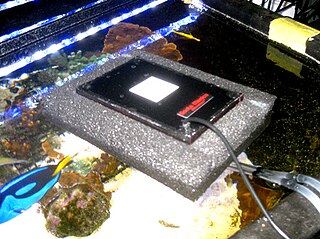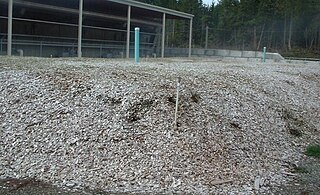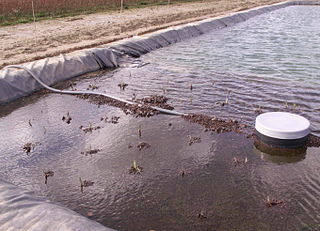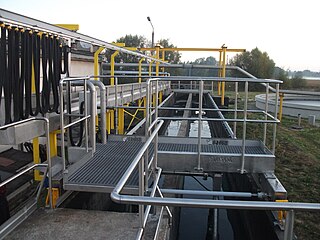 W
WAn algae scrubber is a water filtering device which uses light to grow algae; in this process, undesirable chemicals are removed from the water. Algae scrubbers allow saltwater, freshwater and pond hobbyists to operate their tanks using natural filtration in the form of primary production, much like oceans and lakes.
 W
WRiver Bank filtration is a type of filtration that works by passing water to be purified for use as drinking water through the Banks of a river or lake. It is then drawn off by extraction wells some distance away from the water body. The process may directly yield drinkable water, or be a relatively uncomplicated way of pre-treating water for further purification.
 W
WA Berkefeld filter is a water filter made of diatomaceous earth (Kieselguhr). It was invented in Germany in 1891, and by 1922 was being marketed in the United Kingdom by the Berkefeld Filter Co. Berkefeld was the name of the owner of the mine in Hanover, Germany, where the ceramic material was obtained.
 W
WBiofiltration is a pollution control technique using a bioreactor containing living material to capture and biologically degrade pollutants. Common uses include processing waste water, capturing harmful chemicals or silt from surface runoff, and microbiotic oxidation of contaminants in air.
 W
WA biosand filter (BSF) is a point-of-use water treatment system adapted from traditional slow sand filters. Biosand filters remove pathogens and suspended solids from water using biological and physical processes that take place in a sand column covered with a biofilm. BSFs have been shown to remove heavy metals, turbidity, bacteria, viruses and protozoa. BSFs also reduce discoloration, odor and unpleasant taste. Studies have shown a correlation between use of BSFs and a decrease in the occurrence of diarrhea. Because of their effectiveness, ease of use, and lack of recurring costs, biosand filters are often considered appropriate technology in developing countries. It is estimated that over 200,000 BSFs are in use worldwide.
 W
WBrita GmbH is a German company which manufactures water filters.
 W
WCeramic water filters (CWF) are an inexpensive and effective type of water filter that rely on the small pore size of ceramic material to filter dirt, debris, and bacteria out of water. This makes them ideal for use in developing countries, and portable ceramic filters are commonly used in backpacking.
 W
WA Chamberland filter, also known as a Pasteur–Chamberland filter, is a porcelain water filter invented by Charles Chamberland in 1884. It was developed after Henry Doulton's ceramic water filter of 1827. It is similar to the Berkefeld filter in principle.
 W
WA coffee filter is a coffee-brewing utensil, usually made of disposable paper. This enables it to trap the coffee grounds and allow the liquid coffee to flow through.
 W
WIn chemical engineering, biochemical engineering and protein purification, crossflow filtration is a type of filtration. Crossflow filtration is different from dead-end filtration in which the feed is passed through a membrane or bed, the solids being trapped in the filter and the filtrate being released at the other end. Cross-flow filtration gets its name because the majority of the feed flow travels tangentially across the surface of the filter, rather than into the filter. The principal advantage of this is that the filter cake is substantially washed away during the filtration process, increasing the length of time that a filter unit can be operational. It can be a continuous process, unlike batch-wise dead-end filtration.
 W
WA lava filter is a biological filter that uses lavastone pebbles as support material on which microorganisms can grow in a thin biofilm. This community of microorganisms, known as the periphyton break down the odor components in the air, such as hydrogen sulfide. The biodegradation processes that occurs is provided by the bacteria themselves. In order for this to work, sufficient oxygen as well as water and nutrients is to be supplied.
 W
WThe LifeSaver bottle is a portable water purification device. The bottle filters out objects larger than 15 nanometres.
 W
WA media filter is a type of filter that uses a bed of sand, peat, shredded tires, foam, crushed glass, geo-textile fabric, anthracite, crushed granite or other material to filter water for drinking, swimming pools, aquaculture, irrigation, stormwater management, oil and gas operations, and other applications.
 W
WA petrol interceptor is a trap used to filter out hydrocarbon pollutants from rainwater runoff. It is typically used in road construction and on Petrol Station forecourts to prevent fuel contamination of streams carrying away the runoff.
 W
WThe Portable Aqua Unit for Lifesaving, also known as Water Backpack is a portable membrane water filter developed at the University of Kassel for humanitarian aid. It allows the decentralized supply of clean water in emergency and disaster situations.
 W
WPur is a division of Helen of Troy Limited that produces Pur Water products. Pur products include water filter faucet mounts, pitchers, side taps, dispensers, coolers, and filtration systems for Kenmore refrigerators of Sears Holdings Corporation.
 W
WA Ranney Collector is a patented type of radial well used to extract water from an aquifer with direct connection to a surface water source like a river or lake. The amount of water available from the collector is typically related more to the surface water source than to the piezometric surface of the aquifer.
 W
WThe rapid sand filter or rapid gravity filter is a type of filter used in water purification and is commonly used in municipal drinking water facilities as part of a multiple-stage treatment system.
 W
WSand filters are used as a step in the water treatment process of water purification.
 W
WA sand separator is a device that separates sand or other solids from water.
 W
WSlow sand filters are used in water purification for treating raw water to produce a potable product. They are typically 1 to 2 metres deep, can be rectangular or cylindrical in cross section and are used primarily to treat surface water. The length and breadth of the tanks are determined by the flow rate desired by the filters, which typically have a loading rate of 200 to 400 litres per hour per square metre.
 W
WA traveling screen is a type of water filtration device that has a continuously moving mesh screen that is used to catch and remove debris. This type of device is usually found in water intake systems for drinking water and sewage treatment plants. Screening is considered the first step in conventional sewage treatment processes. Screening is also used in cooling water intakes in steam electric power plants, hydroelectric generators, petroleum refineries, and chemical plants. Traveling screens are used to divert fish, shellfish and other aquatic species, and debris including leaves, sticks, and trash; for the purpose of preventing damage to a facility's treatment or cooling system.
 W
WA vortex filter is a filter used in rainwater harvesting systems to separate medium to large sized debris from the flow of water before the water flows into a tank, cistern or reservoir. by directing the flow around the inside of the wall of the filter housing. Any material with a density greater than water is pushed to the outside and allows cleaner water to flow through a central fine mesh basket into the supply pipe.
 W
WA water filter removes impurities by lowering contamination of water using a fine physical barrier, a chemical process, or a biological process. Filters cleanse water to different extents for purposes such as providing agricultural irrigation, accessible drinking water, public and private aquariums, and the safe use of ponds and swimming pools.